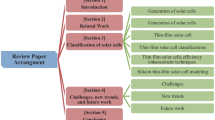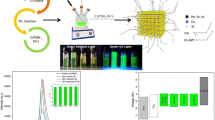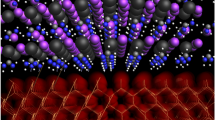Abstract
The study presents the typical aspects of silicon thin films in terms of growth under variation of applied power using Radio frequency Plasma Enhanced Chemical Vapor Deposition technique (RF-PECVD). The corresponding material found to maintain the typical properties of amorphous nature without compensating the structural modification in terms of crystallinity and has been defined as a material having the “sub-nanocrystalline phase”. Characterizations like, UV-Visible spectroscopy, Photoluminescence and Temperature dependent conductivity was used to effectively map the structural details along with electrical and optical properties. The optical bandgap of the films found to be vary from 1.77 eV to 1.99 eV with typical photoresponse variations in the range 103 to 101. At 30 W applied power, the transition regime observed with the formation of sub-nanocrystallites. The analysis of such phase reveals the superior optoelectronic properties. This article suggests the suitability of sub-nanocrystalline silicon thin films to replace hydrogenated amorphous silicon in various applications.
Similar content being viewed by others
References
Chopra KL, Paulson PD, Dutta V (2004). Prog Photovolt Res Appl 12:69
Guha S (1998). Renewable Energy 15:189
R.A. Street. Cambridge University press (2005)
Bryon L. Stafford. No. CONF-91022. American Inst. of Physics, New York, NY (United States) (1991)
Guha S, Yang J, Czubatyj W, Hudgens SJ, Hack M (1983). Appl Phys Lett 42:588
H. Fritzsche and AZ Tucson. In Materials Research Society Symposium Proceedings, Materials Research Society, 467(1997) 19–30
M. Stutzmann. In MRS Proceedings Cambridge University Press 467 (1997) 37
Fritzsche H (1995). Solid State Communications 94:953
Hazra S, Ray S (1998). Solid State Commun 109:125
Mukhopadhyay S, Chowdhury A, Ray S (2008). Thin Solid Films 516:6824–6828
Tan H, Babal P, Zeman M, Smets AH (2015). Sol Energy Mater Sol Cells 132:597
Shah AV, Meier J, Vallat-Sauvain E, Wyrsch N, Kroll U, Droz C, Graf U (2003). Sol Energy Mater Sol Cells 78:469
C. Ballif, J. Bailat, D. Dominé, J. Steinhauser, S. Faÿ, M. Python and L. Feitknecht. PV-lab-CONF-2006-003 (2006)
Sharma M, Juneja S, Sudhakar S, Chaudhary D, Kumar S (2016). Mater Sci Semicond Process 41:43
V.M. Agranovich and D. Taylor. Elsevier, 30 (2001)
Kumar S, Dixit PN, Rauthan CMS, Parashar A, Gope J (2008). J Phys Condens Matter 335215:20
Das D, Bhattacharya K (2006). Journal of Applied Physics 103701:100
Vasiliev I, Öğüt S, Chelikowsky JR (2001). Phys Rev Lett 1813:86
Brus LE (1984). The Journal of Chemical Physics 4403:80
Canham LT (1990). Appl Phys Lett 1046:57
Liao XB, Kong GL, Yang XR, Wang PD, Chao YQ, Chen ZM, Liu CL (1981). Le Journal de Physique Colloques C4-663:42
T.H. Gfroerer, Encyclopedia of analytical chemistry: applications, theory and instrumentation (2006)
K.E. Drexler, Anchor book publishers, New York, (1986)
Hu ZJ, Zhang WG, Hüttinger KJ, Reznik B, Gerthsen D (2003). Carbon 41:749
M. Thorpe, and M. Chubynsky, Department of Physics and Astronomy, Michigan State University, East Lansing, MI 48824. 9(2012) 61
Smets AHM, Kessels WMM, Van de Sanden MCM (2003). App Phys Letts 82:1547
Cheng IC, Wagner S (2003) IEEE proceedings-circuits. Devices and Systems 150:339
Nguyen HH, Nguyen VD, Trinh TT, Jang K, Baek K, Raja J, Yi J (2011). J Electrochem Soc 158:H1077
Acknowledgments
The authors are thankful to Director, CSIR National Physical Laboratory, New Delhi (India) for his kind support. We are also grateful to Dr. Bipin Gupta from CSIR-NPL for availing PL characterization facility. One of the authors (MS) would like to acknowledge Science and Engineering Research Board (SERB), Govt. Of India for providing National Post-Doc Fellowship (NPDF).
Author information
Authors and Affiliations
Corresponding author
Additional information
Publisher’s Note
Springer Nature remains neutral with regard to jurisdictional claims in published maps and institutional affiliations.
Rights and permissions
About this article
Cite this article
Sharma, M., Chaudhary, D., Sudhakar, S. et al. Intrinsic Sub-Nanocrystalline Silicon Thin Films: Active Layer for Solar Cells. Silicon 13, 1–7 (2021). https://doi.org/10.1007/s12633-020-00403-7
Received:
Accepted:
Published:
Issue Date:
DOI: https://doi.org/10.1007/s12633-020-00403-7




